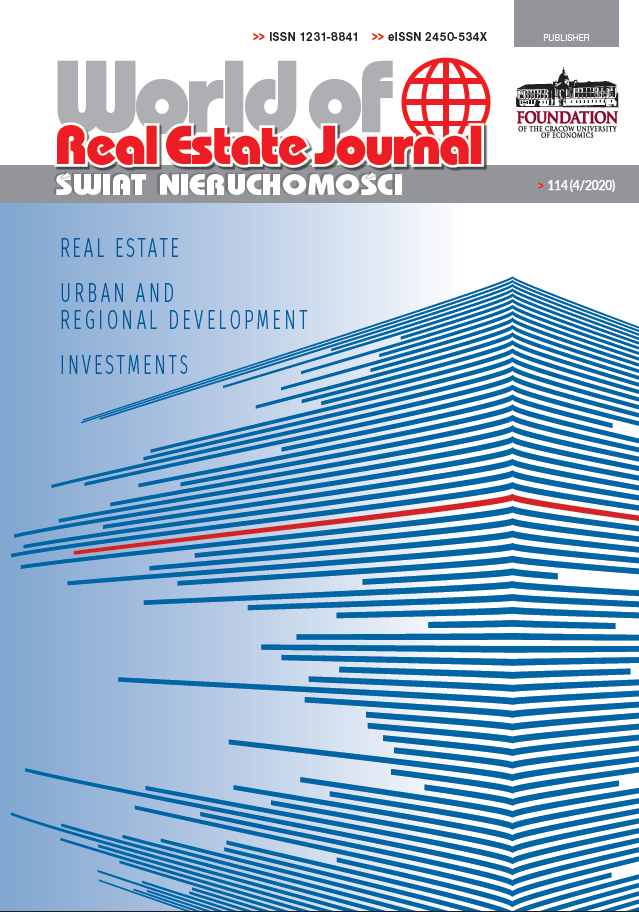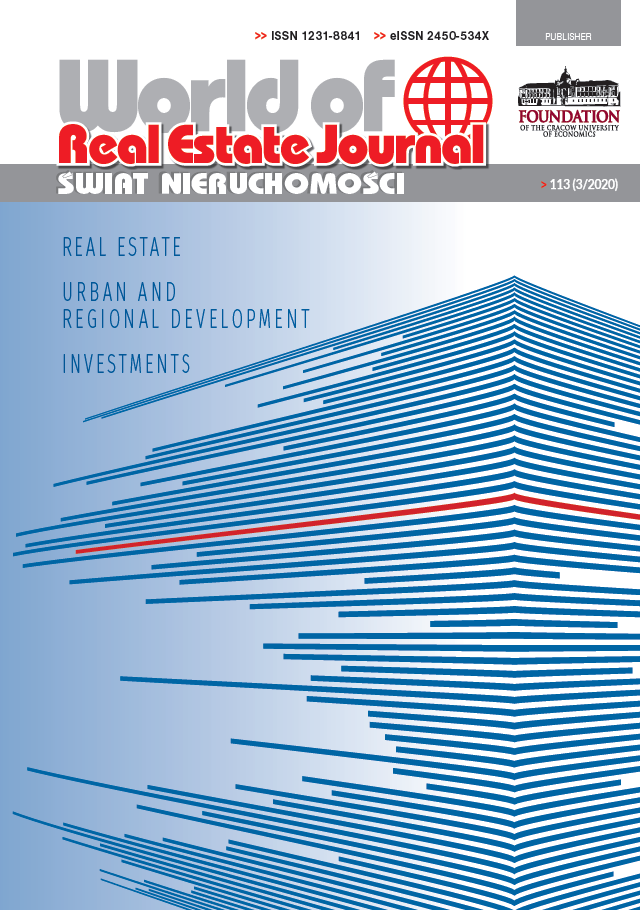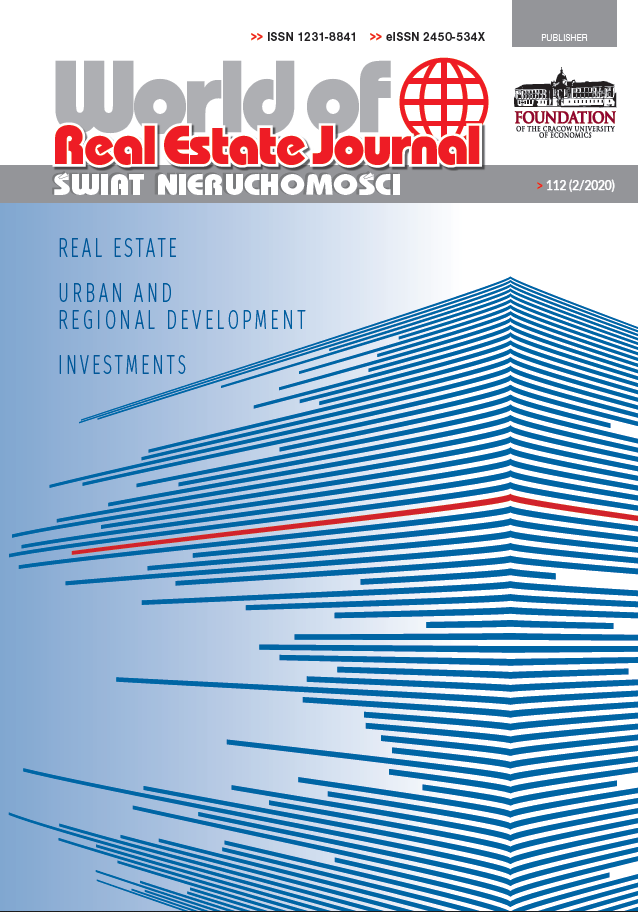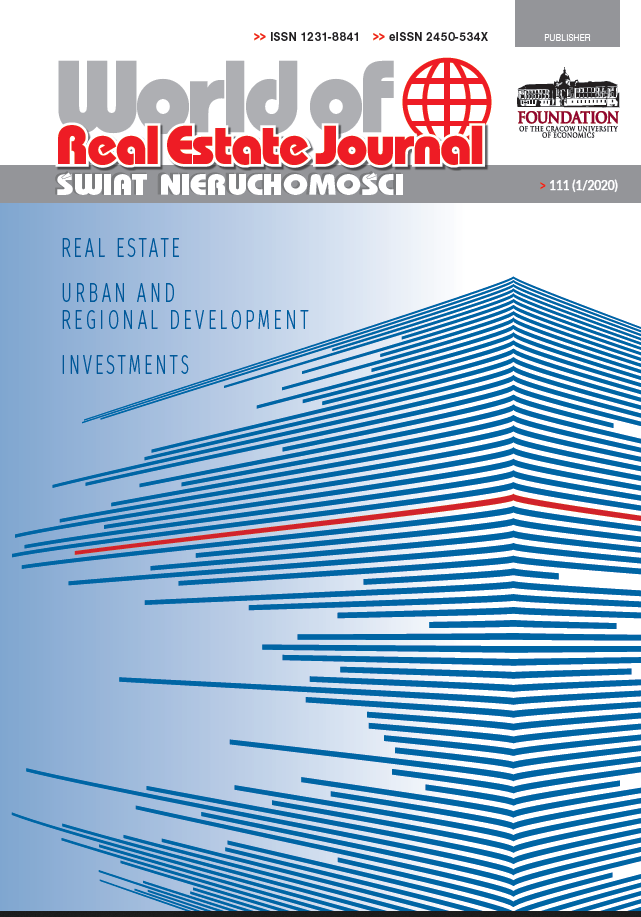MARKET
1) Leszek Kałkowski – The Information Base of the Polish Real Estate Market Monitoring
2) Oksana Kuryj-Wysocka, Agnieszka Osiecka - Determinants of Valuables Area in the Dwelling Property Market Illustrated with an Example of Olsztyn
3) Elżbieta Kanak - Developers’ Relations with Entities of the Environment on the Residential Market
PROBLEMS OF URBAN DEVELOPMENT
4) Janusz Jeżak, Maciej W. Wierzchowski - The Effect of the Decision on Development Conditions on the Spatial Order of Polish Cities
HOUSING
5) Magdalena Załęczna - Social Housing in the Light of the Rules of State Aid
6) Justyna Kłobukowska - Housing Policy in the Context of the Aging Society – Basic Challenges
7) Joanna Różańska–Putek - Demographic Changes in Szczecin as a Factor Shaping Housing Demand
8) Katarzyna Kania, Katarzyna Najbar - Activities of Municipalities in Respect of Housing - the Example of Krakow Municipality
FINANCE
9) Krzysztof Drachal - Housing Loan Rates and Other Interest Rates
10) Piotr Musiał, Roger Śliwicki - Legal and Fiscal Effects of the Temporary Building Object Definition
CHANGES IN REAL ESTATE LAW
11) Maciej J. Nowak - New Jurisdiction and its Impact on Spatial Planning DOWNLOAD
CONFERENCES
12) Dariusz Trojanowski, Anna Wojewnik-Filipkowska - Jubilee Conference of the Department of Investment and Real Estate of the University of Gdańsk entitled “Investment and Real Estate in the Conditions of Sustainable Development” (Sopot, 16-17 June 2014) DOWNLOAD
13) Michał Głuszak -21st European Real Estate Society (ERES) Conference (Romania, Bucharest 25-28 June 2014) DOWNLOAD
IN PUBLISHING MARKET
14) Jan Konowalczuk - „Wycena nieruchomości do celów kredytowych” – Poltext Publishing House Offer DOWNLOAD
SUMMARIES
Leszek Kalkowski - The Information Base of the Polish Real Estate Market Monitoring
The market monitoring system is a significant component of the real estate market and its proper functioning. Decisions made by regulative bodies/authorities, real estate market service and support institutions, research and analysis institutions, investors, borrowers are supported by the data delivered by the monitoring system. Information from the monitoring is required on the local, regional, and national level. The institutionalized system of the real estate market information in Poland is based on the data from notary acts collected by the Central Statistical Office. Despite collecting and delivering important information about the turnover value and the structure of transactions, the system has some significant disadvantages, such as: incompleteness (information on a certain type of transactions is not collected), outdatedness – the data are published with considerable delay, maladjustment of the contents of the data published to users’ needs – commercial users, regulative and administrative authorities, research and educational institutions. The provision of proper and stable financing and institutionalizing of the monitoring system remains another unsolved issue.
Keywords: real estate market data, real estate market turnover, market monitoring
JEL Classification: R30
Citation (APA): Kałkowski, L. (2014). Baza informacyjna monitoringu polskiego rynku nieruchomości. Świat Nieruchomości, (3(89)), 5-12.
DOI: 10.14659/worej.2014.89.01
Oksana Kuryj-Wysocka, Agnieszka Osiecka - Determinants of Valuables Area in the Dwelling Property Market Illustrated with an Example of Olsztyn
Due to its characteristics, real estate is considered to be one of the barometers of the coming changes in the business cycle. Both for the investor and the owner, the real estate has some potential expressed in the value of the real estate. However, determining the value, in the context of the potential, is an extremely difficult task because every man can perceive one real estate differently. The reference point of the man to the real estate is reflected in the notion of real estate valuables. The real estate valuables area is a dynamic category, it undergoes constant changes and modifications, both in the individual stages of the market development cycle, and during the product - the real estate - life cycle. The aim of this paper is to define factors determining the valuables area in the dwelling property, and designating the levels of valuables in the selected housing estates in Olsztyn.
Keywords: real estate development cycle, real estate life cycle, valuables area
JEL Classification: E32, R31
Citation (APA): Kuryj-Wysocka, O., Osiecka, A. (2014). Determinanty pola cenności nieruchomości lokalowych na rynku na przykładzie Olsztyna. Świat Nieruchomości, (3(89)), 13-20.
DOI: 10.14659/worej.2014.89.02
Elżbieta Kanak - Developers’ Relations with Entities of the Environment on the Residential Market
The article discusses the problem of building, maintaining and developing relationships of developers with affiliated enterprises. Developers can actively shape their relationships with entities in their environment. Maintaining and developing relationships is important for the development of the company and the developers should be strongly involved in these activities. The result of effective management of the relationship with the environment is an increase in their competitiveness, the reduction of marketing costs, the growth of loyalty of entities in the environment to the firm. Attention to customer satisfaction - home buyers, but also partnerships with suppliers, cooperating companies, brokers, banks, institutions regulating the market, the media and their own staff should be at the desired level, so that an enterprise can develop in a dynamic competitive environment.
Keywords: developer, relationships, entities of the environment
JEL Classification: R3
Citation (APA): Kanak, E. (2014). Relacje deweloperów zpodmiotami otoczenia na rynku nieruchomości mieszkaniowych. Świat Nieruchomości, (3(89)), 21-24.
DOI: 10.14659/worej.2014.89.03
Janusz Jeżak, Maciej W. Wierzchowski - The Effect of the Decision on Development Conditions on the Spatial Order of Polish Cities
The subject of the article is the institution of the decision on development conditions, regulated by the Spatial Planning and Development Act of 27th March 2003. In the perfect or even utopian system - as one may think – in current Polish conditions, the decision on planning conditions should be “merged in” the planning process. This process should respect the rules of the sustainable development of cities. Practically speaking, due to erratic legal regulations, the integrated cities' development strategies – even these created correct (according to the Leipzig Charter on Sustainable European Cities and the rules of the urban planning “art”) represent only propaganda value, useful only during election campaigns, or didactic value (which shows how “far away” from each other are noble ideas and bland practice). It has been six years since the signing of the Leipzig Charter, a period which was squandered in Polish conditions. There still exists a lack of legal instruments which could allow elimination of systemic causes of the existing pathologies in the spatial management of Polish cities. Some of these instruments are easy to introduce – e.g. the ones regarding the provision which states that the Study of conditions and directions of spatial development in a commune is of local law character. Others require a deeper afterthought – in order to take the experience of economically developed EU countries into account. This afterthought should regard the institution of the decision on development conditions, including i.e. the rules of delimiting the effect area, continuation of function or nearby properties.
Keywords: decision on development conditions, spatial order, development of cities, spatial order, Polish cities
JEL Classification: R14, R52, R58
Citation (APA): Jeżak, J., Wierzchowski, M. (2014). Wpływ decyzji owarunkach zabudowy na ład przestrzenny polskich miast. Świat Nieruchomości, (3(89)), 25-30.
DOI: 10.14659/worej.2014.89.04
Magdalena Załęczna - Social Housing in the Light of the Rules of State Aid
Difficulty in meeting housing needs, resulting from the economic downturn and current demographic and cultural trends, drew the attention of politicians in the EU to the social housing segment. In recent years it has been reformed to introduce a higher level of efficiency, however, legal and interpretational problems have emerged. First of all, there was a problem of distortion of competition between social housing and privately rented residential properties. The problem of state aid in the context of social housing has been the subject of decisions of the Court of Justice. The aim of the article is to introduce the readers to this issue.
Keywords: Social housing, state aid, competition
JEL Classification: K3, R31, Z18
Citation (APA): Załęczna, M. (2014). Mieszkalnictwo społeczne wświetle przepisów opomocy publicznej. Świat Nieruchomości, (3(89)), 31-34.
DOI: 10.14659/worej.2014.89.05
Justyna Kłobukowska - Housing Policy in the Context of the Aging Society – Basic Challenges
The diverse preferences and expectations of elderly people pose a new challenge to the housing policies. The future role of housing policy is not as straightforward as it may seem at first glance. The group of elderly people will be requiring modified dwellings and access to other innovative solutions which will make possible spending the rest of life in suitable housing conditions. The article presents main problems connected with aging societies, increasing housing needs and housing policy.
Keywords: housing policy, real estate market, aging societies
JEL Classification: J11, R31
Citation (APA): Kłobukowska, J. (2014). Zmiany demograficzne wSzczecinie jako czynnik kształtowania się popytu na nieruchomości mieszkaniowe. Świat Nieruchomości, (3(89)), 35-40.
DOI: 10.14659/worej.2014.89.06
Joanna Różańska–Putek - Demographic Changes in Szczecin as a Factor Shaping Housing Demand
In this work, demographic patterns of the city of Szczecin are examined in the context of the housing demand. The aim is to describe the demographic profile of Szczecin and to analyze its main components that affect the housing market now and in the future. The analysis is conducted using mainly the National Census of Population and Housing 2011 data. Key topics include the population size and structure, marriages, divorces and migration. It is shown that besides the declining population size, some other significant patterns may be observed that impact the housing market and may change the qualitative aspects of the housing demand. Such factors include postponed and diversified union and family formation processes, an increasing number of less numerous families and singles, and a growing potential of the elderly population.
Keywords: demographic changes, housing demand, NCHP 2011, Szczecin
JEL Classification: J11, R21
Citation (APA): Różańska-Putek, J. (2014). Zmiany demograficzne wSzczecinie jako czynnik kształtowania się popytu na nieruchomości mieszkaniowe. Świat Nieruchomości, (3(89)), 41-48.
DOI: 10.14659/worej.2014.89.07
Katarzyna Kania, Katarzyna Najbar - Activities of Municipalities in Respect of Housing - the Example of Krakow Municipality
In Poland, municipalities play a key role in pursuing the housing policy focused on satisfying the housing needs of the local community. The housing stock of a municipality was separated mainly to satisfy the housing needs of households which achieve a relatively low income and are not able to cope with this task alone. Therefore, a municipality should take all actions which promote the effective use of the existing housing stock. However, because of burdens arising from the transformation of the previous economic system, actions taken by municipalities in respect of housing are often not able to meet the needs of part of the local community. In the article the authors indicate the specificity of the problems in the field of housing policy of Krakow Municipality (KM) and the ensuing KM activity in the management of the owned housing stock in the view of the applicable law.
Keywords: housing, municipality, housing stock, housing policy
JEL Classification: R38
Citation (APA): Kania, K., Najbar, K. (2014). Działania gmin wzakresie mieszkalnictwa na przykładzie Gminy Miejskiej Kraków. Świat Nieruchomości, (3(89)), 49-54.
DOI: 10.14659/worej.2014.89.08
Krzysztof Drachal - Housing Loan Rates and Other Interest Rates
The article presents the development of housing loan rates between 2004 and 2013. The monthly data were taken. The methodology is based on cointegration analysis with the help of the Engle-Granger method. Selected interest rates cointegration is studied. It was found out that only some of the analyzed rates are cointegrated. It is only partially consistent with the previously known results from other economies. However, some of the results show significantly different behavior.
Keywords: cointegration, housing loan rates, interest rates
JEL Classification: E43, G21, R30
Citation (APA): Drachal, K. (2014). Oprocentowanie kredytów na nieruchomości mieszkaniowe na tle innych stóp procentowych. Świat Nieruchomości, (3(89)), 55-60.
DOI: 10.14659/worej.2014.89.09
Piotr Musiał, Roger Śliwicki - Legal and Fiscal Effects of the Temporary Building Object Definition
The concept of a temporary building object comes within the sphere of the building law. However, according to the tax law, it is not so obvious that such a building can be taxed in the same way as other real estates. The article gives a look at the tax law problems related to the notion of a temporary building object. After a short description of statutory concepts arising from the Civil Code, the Building Law Act, the Local Tax and Charges Act, the authors indicate that the same legal term is clearly legislatively unfinished in different acts of codified law and by means of judicature (Voivodship Administrative Court, Supreme Administrative Court), they also search for a coherent solution of problems with taxation of temporary building objects.
Keywords: temporary building object, tax, judicature
JEL Classification: K34
Citation (APA): Musiał, P., Śliwicki R. (2014). Oprocentowanie kredytów na nieruchomości mieszkaniowe na tle innych stóp procentowych. Świat Nieruchomości, (3(89)), 61-64.
DOI: 10.14659/worej.2014.89.10





















































